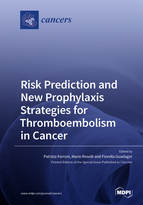Risk Prediction and New Prophylaxis Strategies for Thromboembolism in Cancer
A special issue of Cancers (ISSN 2072-6694).
Deadline for manuscript submissions: closed (31 January 2020) | Viewed by 47882
Special Issue Editors
2. Department of Human Sciences and Promotion of the Quality of Life, San Raffaele Roma Open University, 00166 Rome, Italy
Interests: biomarker discovery; decision support systems; predictive medicine; artificial intelligence
Special Issues, Collections and Topics in MDPI journals
Interests: cancer chemotherapy; venous thromboembolism; decision support systems; predictive medicine
Special Issues, Collections and Topics in MDPI journals
2. Department of Human Sciences & Quality of Life Promotion, San Raffaele Roma Open University, 00166 Rome, Italy
Interests: biomarker discovery; cancer biomarkers; decision support systems; predictive medicine; artificial intelligence
Special Issues, Collections and Topics in MDPI journals
Special Issue Information
Dear Colleagues,
Thromboembolism is a compelling challenge in cancer care because of its life-threatening nature as well as impact on specific treatments. Current guidelines do not generally recommend antithrombotic prophylaxis, except in selected categories of patients at high risk of thrombosis. Accordingly, several clinical decision models have been developed to guide the oncologist in thromboembolic risk assessment and targeted prophylaxis.
Low molecular weight heparin (LMWH) are currently considered as the standard approach in clinical practice guidelines, but recent randomized controlled trials (RCT) have indicated that direct oral anticoagulants (DOACs) are effective for the treatment/prophylaxis of cancer-associated thromboembolism. However, many unanswered questions remain on the efficacy and safety of anticoagulants in selective cancer subgroups, and in primary and secondary prevention settings, where anticoagulation needs to be balanced on the risk of bleeding complications. Tailored approaches based on the use of individualized factors to stratify the thrombotic/bleeding risk in each individual patient will represent a significant advance in the prevention of cancer-associated thromboembolism.
This Special Issue will cover the current clinical evidence supporting the standard of care and emerging treatment/prophylactic options for cancer-associated thromboembolism. Evidence on anticoagulant effects on the quality-of-life perception in cancer patients will be also welcomed.
Prof. Patrizia Ferroni
Prof. Mario Roselli
Prof. Fiorella Guadagni
Guest Editors
Manuscript Submission Information
Manuscripts should be submitted online at www.mdpi.com by registering and logging in to this website. Once you are registered, click here to go to the submission form. Manuscripts can be submitted until the deadline. All submissions that pass pre-check are peer-reviewed. Accepted papers will be published continuously in the journal (as soon as accepted) and will be listed together on the special issue website. Research articles, review articles as well as short communications are invited. For planned papers, a title and short abstract (about 100 words) can be sent to the Editorial Office for announcement on this website.
Submitted manuscripts should not have been published previously, nor be under consideration for publication elsewhere (except conference proceedings papers). All manuscripts are thoroughly refereed through a single-blind peer-review process. A guide for authors and other relevant information for submission of manuscripts is available on the Instructions for Authors page. Cancers is an international peer-reviewed open access semimonthly journal published by MDPI.
Please visit the Instructions for Authors page before submitting a manuscript. The Article Processing Charge (APC) for publication in this open access journal is 2900 CHF (Swiss Francs). Submitted papers should be well formatted and use good English. Authors may use MDPI's English editing service prior to publication or during author revisions.
Keywords
- cancer-associated thromboembolism
- low molecular weight heparin
- direct oral anticoagulants
- bleeding risk
- risk assessment
- thromboprophylaxsis
- treatment









